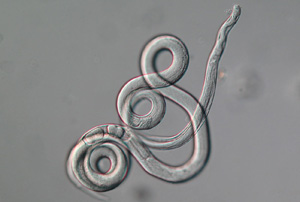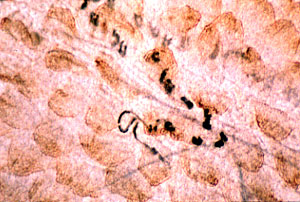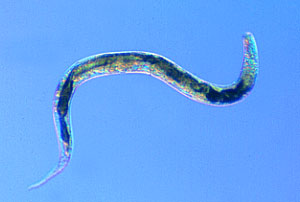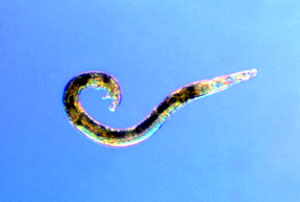Strongyloides spp. are a genus of parasitic nematode. More than 50 million people are infected with S. stercoralis (one of the two species of Strongyloides able to infect humans) worldwide, though this is probably an underestimate.
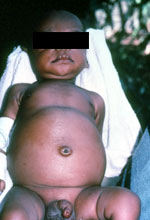
Strongyloides infections of humans can be fatal in two situations. Firstly, individuals who are immunosuppressed (artificially or by other disease) are susceptible to a disseminated, and usually fatal, Strongyloides infection. Secondly, in areas of New Guinea Strongyloides is the causative agent of 'Swollen Baby (or Belly) Syndrome' in which young infants develop massive Strongyloides infections, which are fatal unless rapid treatment is given. S. ratti is an common parasite of rats, which is amenable to laboratory study and manipulation.
The life-cycle of Strongyloides ratti
The life-cycle of S. ratti has both a parasitic and a free-living generation (Figure).
Life-cycle of S. ratti with two discrete developmental switches: 1. a sex determination event; 2. a female-only developmental switch. Click on the names of the stages to see an image.
The parasitic generation consists solely of adult parasitic females, which live embedded in the mucosa of the small intestine of rats. These parasitic females reproduce by mitotic parthenogenesis. Male and female eggs produced by these females are passed with the host faeces into the external environment.
In the environment male eggs hatch and the resulting larvae moult through four larval stages (not shown above) to finally develop into free-living adult males.
Female eggs similarly hatch in the environment, however the resulting larvae have a developmental choice. In female indirect (heterogonic) development, female larvae develop into free-living adult females. The free-living adult males and females mate, reproduce sexually, and the female then lays eggs. These eggs hatch, and larvae moult through larval stages (not shown above) into infective third stage larvae (iL3s), which infect new hosts by penetrating their skin. The iL3 stage is developmentally arrested and will not develop further until it encounters a host. In female direct (homogonic) development female larvae develop via two larval stages into iL3s directly, which can similarly infect hosts.
Despite being an obligate parasite a significant part of the Strongyloides life-cycle occurs outside of the host. This has the practical advantage that the free-living stages can be readily grown and manipulated in faeces from infected animals.
The control of the developmental choice
The developmental choices in the life-cycle are affected by a number of factors. There are important genetic effects. This is shown by different isofemale lines of Strongyloides varying in the proportion of larvae which develop by each route. Isofemale lines can also be artificially selected for different developmental routes.
The environmental conditions that young larvae encounter also affects their developmental choice. For S. ratti the host immune response affects both the sex ratio of the eggs passed by an infected host (Box 1, above) and the female-only developmental choice (Box 2, above), with a more male biased sex ratio and development of free-living adult females favoured by larvae passed from an immune host. The environmental temperature external to the host also affects the female-only developmental choice (Box 2, above) with development into free-living adult females favoured at higher environmental temperatures.
Putting this together, S. ratti integrates a number of different factors when making developmental decisions. This shows the importance of young larvae making the right developmental decision. It also means that experimentally we can manipulate the developmental decisions of this parasite's life-cycle.
